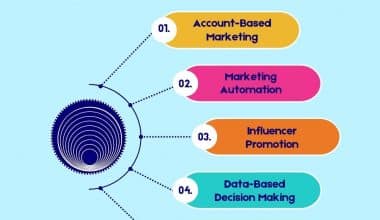When it comes to selling products and services, digital commerce encompasses the entire transaction. The word refers to more than just the actual act of making a purchase or payment through the Internet; it also includes the steps taken before and afterward. This includes activities such as supply chain management, data analytics, market research, and customer acquisition. This article explains the digital commerce solution and the list of available platforms. We also added the list of digital commerce banks you can choose from to help with each of your financial transactions. Therefore, let’s dive into the main deal!
What Is Digital Commerce?
The term “digital commerce” refers to the practice of buying and selling physical goods and services using digital means. To complete a transaction, multiple individuals and organizations must interact and exchange some form of data or money. It is a subset of the broader field of electronic business (e-business), which encompasses everything needed to manage a business in the digital realm.
The advent of digital commerce has allowed previously underserved enterprises (such as tiny ones) to expand their customer bases and product offerings through the use of more cost-effective and streamlined distribution methods. Target (TGT) offers an online store where customers can buy everything from apparel and coffeemakers to toothpaste and action figures, without ever having to leave the comfort of their own homes.
It’s not as simple as it seems to supply goods and services. It takes an extensive study of the products or services you plan to sell, the market, your target demographic, the competitors, and your startup costs. Once everything is settled, you can move on to choosing a name and establishing a formal organization like a corporation.
How Does Digital Commerce Work?
Successful digital commerce relies heavily on automation, and automation works best when it’s backed up by data. The success of digital commerce depends on a number of factors, including the availability of large amounts of data and the sophistication of available analytics tools.
In spite of their efficiency and low overhead, global supply networks are vulnerable to disruptions from natural disasters, pandemics, wars, and other factors. Using data as the foundation for predictive analytics, online stores can anticipate negative outcomes based on factors like frequency, seasonality, and more.
Digital commerce is really omnichannel, as it can be accessed from any device at any time. In order to achieve such granularity, it is necessary to create road maps for every imaginable situation and to back them up with automated technologies that manage everything from inventory to customer satisfaction.
Types of Digital Commerce
The following are the types of digital commerce:
#1. Business to Consumer (B2C)
Companies that engage in business-to-consumer (B2C) digital commerce sell directly to consumers. Direct interactions with the end user, as opposed to supplying an intermediate, characterize business-to-consumer (B2C) models. Business models like these can be used to sell anything from physical things (like an online sporting goods store) to services (like lawn care software that allows customers to schedule landscaping appointments). Most people’s mental image of what digital commerce entails conforms to this most typical business model.
#2. Business to Business (B2B)
Businesses use the business-to-business (B2B) model of digital commerce to sell their wares to other companies. These transactions are rare but typically involve substantial sums of money. Some companies get around this constraint by offering perpetual or periodic subscriptions. B2B digital commerce is most frequently seen in the purchase of goods and services online without face-to-face interaction. Software products for automation include HubSpot and Lightspeed, while other examples include the communication applications Slack and Trello.
#3. Business to Government (B2G)
When it comes to delivering goods and services to government agencies and administrations, some businesses excel. In a business-to-business connection, like this one, both parties exchange goods or services of value. Business-to-government (B2G) digital commerce frequently faces strict product and service requirements from government RFPs, bid requests, and project specifications. Another possibility is a consolidated bid for government services through a government-wide purchasing contract.
#4. Consumer to Consumer (C2C)
Only well-established businesses may make sales. Digital marketplaces are one type of digital commerce platform that facilitate the selling of goods and services between individuals. These C2C marketplaces could be straightforward auctions (like eBay) or more involved discussions (like Craigslist ads) about the goods or services on offer. Technology-enabled C2C digital marketplace allows customers to buy and sell directly from one another without the involvement of businesses.
#5. Consumer-to-business (C2B)
Review systems are the most effective way to illustrate the consumer-to-company digital commerce paradigm. Customers are given badges and rewards points for helpful reviews on Amazon, where review requests are created automatically by the site. Customers’ transactional value is captured since an in-depth evaluation can lead to increased sales. Consumer-to-business (C2B) refers to the flow of value from consumers to companies.
Digital Commerce Banks
Having an online store can greatly increase your business’s exposure and revenue. The appropriate bank can make all the difference if your company operates a digital Commerce storefront and you need assistance managing and processing transactions and your funds. With the data gleaned from a digital banking software or platform, you can better understand the inner workings of your company and make informed decisions about its future direction and financial stability. Here is a list of some digital commerce banks:
#1. Novo
Novo is an electronic banking system well-suited to the needs of Internet merchants and nomadic professionals. There are no costs associated with opening a Novo account, nor are there any ongoing monthly charges. With a Novo account, you can handle your finances online, from invoicing and payment to transferring money and even scanning checks. It is one of the best digital commerce banks you can go for.
#2. Airwallex
Airwallex was established in Melbourne in 2015 with an initial focus on providing international payment services. It’s not technically a bank, but it does most of what a bank does, including accepting deposits, making loans, and issuing credit cards.
#3. Payoneer
Payoneer, headquartered in New York City, is rapidly expanding to become a dominant player in the financial payment processing industry. Users of Payoneer can apply for and acquire a virtual bank account number that can be used for making and receiving payments. There has been a recent uptick in the number of businesses and retailers using Payoneer. E-commerce platforms like eBay, Rakuten, and even Amazon are supported by Payoneer.
#4. Neat
Neat is a Hong Kong-based company founded in 2015 with the goal of revolutionizing cross-border financial services. It primarily supports e-commerce companies as well as small and medium-sized organizations (SMEs). Neat is a worldwide account system that facilitates local and international monetary transactions for businesses. It’s also compatible with other programs and sites used in the digital commerce industry, so you can keep track of everything in one location.
#5. N26
Digital bank N26, located in Germany, offers services in English, Spanish, French, and Italian. N26 was established in 2013 to meet the needs of remote workers by providing them with a simple way to send and receive payments, create and manage invoices, and convert between different currencies. Working with N26 can simplify the handling of your funds and several currencies needed to provide your products or services whether you are a freelancer or operate with clients from all over the world.
#6. Wise
Like Payoneer, Wise is a non-bank alternative for sending and receiving electronic payments. Wise allows users to send, receive, and convert several currencies with low or free fees, depending on the user’s location and the type of currency being used. Since Wise is not a conventional financial institution, its users cannot earn interest on their account balances. However, it is possible to manage payments in multiple currencies, including employee paychecks, vendor payments, and currency exchange.
Digital Commerce Platforms
A digital commerce platform is an all-encompassing piece of software that facilitates the management of a business’s online product or service sales. To facilitate the management of product data, the customization of store content and layout, and the processing of online transactions and payments, digital commerce platforms create a central, digital hub for product and customer data. Some vendors offer business-to-business (B2B) versions of their digital commerce platforms, but the vast majority cater to sales to consumers. While most digital commerce platforms have historically catered to the management of sales of tangible goods, recent years have seen an uptick in the number of options that include support for digital products offered on a subscription basis. Everyone working for a digital commerce company can benefit from this software, but it is especially useful for those in charge of sales, product management, and marketing.
Here is a list of digital commerce platforms:
#1. Shopify
When it comes to e-commerce, Shopify is undoubtedly the best SaaS platform available. With the powerful platform’s supplementary multichannel selling tools and capabilities, you can sell anywhere from your website to brick-and-mortar stores to social media to third-party marketplaces. You can get your online store up and running quickly with no learning curve by selecting from among more than a hundred paid and free themes.
#2. BigCommerce
BigCommerce is one of the best digital platforms available. It’s perfect for larger retail firms due to its powerful product search engine. It’s also a great option for anyone looking to launch their own e-commerce venture or supplement their traditional storefront with online sales. Because of the resources at hand, it can be used effectively in any field or specialty.
#3. Wix
Wix is an intuitive drag-and-drop website creator with pre-made themes, hosting, and domain name registration. It allows you to create a basic website for free, but its e-commerce tools require a premium plan upgrade. It also offers some useful features for facilitating online shopping.
#4. OpenCart
OpenCart is a free, open-source digital commerce platform that is well-known for its adaptability and ease of use. The platform supports the creation and administration of several stores and includes a detailed dashboard displaying key indicators such as sales and client retention. OpenCart provides you with over 13,000 customizable modules and themes, in addition to numerous integrations for bringing together your various web development resources.
#5. Volusion
The Volusion e-commerce platform has been around for quite some time. Since its 1999 debut, Volusion has facilitated the hassle-free launch of online stores for companies. There are no limits on the number of products you may sell or the number of pages you can establish. There is no free option. Another limitation is that you can only provide physical goods for sale on Volusion. You’ll need to choose a different e-commerce platform to offer digital goods like ebooks or music.
#6. Shift4Shop
As of 2015, 3dcart (now Shift4Shop) had served over 22,000 online businesses, with PCMag among them. They offer useful functions like no transaction costs and limitless storage space. Their POS system is multi-channel ready and you may use it to sell your wares. The company became known as Shift4Shop in the year 2021.
#7. Adobe Commerce (formerly Magento)
If you’re a developer looking for one of the most flexible digital commerce platforms, Adobe Commerce is the way to go. Brands who want a unique platform will gain from this, but it also creates significant challenges in the form of complexity and cost. If you want to build up and handle the full infrastructure on your own, you’ll need to have expert-level coding and development skills.
Digital Commerce Trends
The following are digital commerce trends:
#1. Personalization
Cookies, which are pieces of code stored on a user’s computer to “remember” the user and tailor the website’s content to their interests, have changed the online shopping experience. Nowadays, consumers look for brands that can cater to their specific needs; 88% of them believe they are more likely to buy from those companies.
#2. Products with Built-in Interactivity
Augmented and virtual reality are being used as additional touchpoints in the consumer journey by online businesses. Virtual fitting rooms using augmented reality could be used by online clothes merchants, for instance.
#3. Stock Management
Despite technological efforts, stocking products remains a major overhead for online merchants. Large retailers like Target and Walmart are able to leverage store inventory to fill online consumer orders by using sophisticated technology to locate product inventories in brick-and-mortar locations around the country. This avoids the high expense of maintaining two sets of stock, one at the store and one at the warehouse. The necessity for large-scale warehousing is also avoided by large digital commerce companies such as Alibaba Express, which connects consumers directly with suppliers.
#4. Consolidated Advertising
The fragmentation of the consumer experience is a direct result of the proliferation of digital commerce channels. With integrated marketing, brands can provide a consistent digital experience that lives up to customers’ expectations in today’s fragmented digital landscape by coordinating their marketing content across all customer touchpoints.
#5. Automation
To optimize processes and cut expenses, more and more stores are turning to automation. By automating mundane processes like inventory management, marketing, and customer service, e-commerce enterprises are free to concentrate on expanding their operations and providing superior customer service.
#6. API-driven Business
The term “headless commerce” refers to a new way of thinking about online transactions in which the front-end user experience is decoupled from the back-end digital commerce infrastructure. This shift allows companies to better cater to their customer’s needs by creating individualized and adaptable services across all channels and devices.
Challenges of Digital Commerce
The following are some of the challenges of digital commerce:
#1. Delivering Consistent Customer Experiences
Consumers regularly update their standards. In order to readily identify what is working and what needs improvement, retailers should make it a habit to adopt a systematic approach to monitoring customer data. Understanding consumer habits allows you to tailor your services to each individual.
#2. Meeting New Technology Expectations
In 2023, it will be difficult to keep up with all the changes in digital commerce that will be expected by customers. Because of the rapid pace at which technology advances, it is essential that your digital marketing strategies for selling to tech-savvy consumers are continuously updated. Keep in mind that shoppers may often utilize several different digital channels to research brands before making a purchase. Staying on top of digital commerce trends like AI, conversational marketing, personalization, video marketing, visual search, and shoppable posts will help you provide seamless purchasing experiences in an era when consumer behaviors are notoriously difficult to predict.
#3. Generating Enough Traffic
The days of merchants relying solely on one source of traffic to their digital commerce websites are long gone. Experts in digital commerce know how to use search engine optimization (SEO), pay-per-click (PPC) advertising, email marketing, social media, display advertising, retargeting, mobile, comparison shopping engines, and affiliate marketing to drive customers to their online store.
#4. Converting and Retaining Customers
When it comes to lead generation and closing deals, most B2B marketers agree that marketing automation is invaluable. Statistically, 75% of marketers/companies are already employing at least one form of marketing automation tool.
#5. Expanding Business with Technology
Is technology holding you back? The tools you’re using now can be preventing you from progressing, even though you may not be aware of it. In order to achieve sustainable expansion through digital commerce, stores must first lay a solid technological groundwork. Analytics, shopping cart solutions, email software, customer relationship management systems, and inventory management software are just some of the options that need to be thought through at this time.
What Is the Importance of Digital Commerce?
When properly implemented, digital commerce can yield priceless client data. By analyzing consumer information, you can deliver a better-tailored service across all channels. Brands can use customer information to increase revenue, client acquisition, and customer loyalty.
Is Digital Commerce the Same as Digital Marketing?
Digital marketing is a method utilized to draw customers to these establishments, which in turn boosts revenue. E-commerce, or electronic commerce, refers to the practice of buying and selling products and services over the Internet.
How Do I Become an E-Commerce Specialist?
A bachelor’s degree in marketing or a closely related discipline, as well as experience in retail and an understanding of e-commerce best practices, are required to enter the field of e-commerce.
Final Thoughts
To succeed in digital commerce, it is essential to have a firm grasp of what your target demographic values. When you put analytics solutions to work for you, it will be easy to satisfy the needs of today’s modern digital consumer. With the correct digital commerce solution, you can track customers’ preferences and analyze their behavior across channels, from their online searches and browsing habits to the top and bottom performers in your product line. Your online store will succeed if you use these factors in conjunction with sophisticated personalization strategies, artificial intelligence, and cost minimization.
Related Articles
- WHAT IS COMMERCE: Definition, Degree & Importance
- Sales Order Management Software: Top 25 Order Management Software
- Electronic Commerce (e-commerce): Definition, Websites, Advantages, and Disadvantages
- E-commerce Business: Ideas, Models, & 2023 How to Start Guide
- Hot new business ideas 2023 with 100% success rate. Find 10 of them here (+ all you need)






